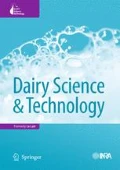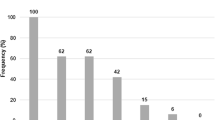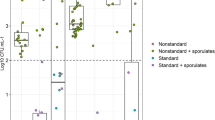Abstract
Bacillus cereus is a food pathogen of major concern to the dairy industry. Strains of B. cereus were isolated in 2006 and 2010 from a pasteurized milk processing line in a dairy plant in Algeria. Pasteurized milk is obtained from reconstituted and processed milk powder. This study was designed to discriminate between the isolated B. cereus strains and to predict their food poisoning potential. Strains were fingerprinted by M13-PCR, and identified at the phylogenetic group level by amplified panC gene sequence analysis. They were clustered into three distinct M13-PCR groups: one major group which included 17 strains and two minor groups which contained two and one strains, respectively. Strains originating from both the process equipment and milk powder were from the major group indicating that milk powder was the main source of initial contamination. Strains from the major and second group were affiliated to the mesophilic phylogenetic group III while the unique strain of the third group was classified into the mesophilic phylogenetic group IV. The data presented in this study showed a very low genetic diversity among B. cereus strains identified in milk powder and secondly by milk processing systems, as well as persistence in the dairy environment of specific B. cereus genotypes, across 4 years. M13-PCR typing and phylogenetic affiliation were useful for characterizing B. cereus dairy isolates, permitting their differentiation within the B. cereus group, and showing homogeneous contamination throughout the pasteurized milk processing line. The recurrent genotypes which belong to the potentially toxigenic group III B. cereus could threaten pasteurized milk safety.
摘要:
蜡状芽孢杆菌是乳品行业中比较受关注的一种食品级病原菌。在2006年和2010年从阿尔及利亚乳品厂巴氏杀菌乳加工生产线上分离出蜡状芽孢杆菌。该工厂巴氏杀菌乳以复原乳和奶粉为原料。本研究目的是分离鉴别蜡状芽孢杆菌并预测他们对食物的潜在毒性。分离的菌株通过M13引物PCR指纹法分析,菌株的系统发育组别水平通过panC 基因序列分析法来鉴定。这些菌株被分成三个不同的M13-PCR菌群: 一个是具有17 菌株的大菌群和两个分别仅含有2株和1株的小菌群。这些菌株既来自加工设备,也来自奶粉,其中奶粉是菌株的主要来源物,奶粉是主要的污染源。来自主要菌群的菌株和次级菌群中的1株菌株属于嗜温菌种属III,然而第三组菌群中仅有的1株菌株属于嗜温菌种属IV。本研究的数据表明从奶粉和奶加工体系中分离的蜡状芽孢杆菌有较低的遗传多样性,在四年生产过程中特殊的蜡状基因型菌株一直存在于乳品环境中。M13-PCR 分类技术和菌种隶属对蜡状芽孢杆菌的定性很有用,允许蜡状芽孢杆菌菌属内部存在差异,同时表明了在整个巴氏杀菌乳生产线上存在相似的污染。重复出现的基因型菌株属于潜在的产毒蜡状芽孢杆菌属III,能够严重威胁到巴氏杀菌乳的安全。


Similar content being viewed by others
References
Aires GS, Walter EH, Junqueira VC, Roig SM, Faria JA (2009) Bacillus cereus in refrigerated milk submitted to different heat treatments. J Food Prot 72:1301–1305
Ankolekar C, Labbé RG (2010) Physical characteristic of spores of food-associated isolates of the B. cereus group. Appl Environ Microbiol 76:982–984
Auger S, Ramaro N, Faille C, Fouillet A, Aymerich S, Gohar M (2009) Biofilm formation and cell surface properties among pathogenic and non pathogenic strains of the Bacillus cereus group. Appl Environ Microbiol 75:6618–6676
Bagge-Ravn D, Ng Y, Hjelm M, Christansen JN, Johansen C, Gram L (2003) The microbial ecology of processing equipment in different fish industries—analysis of the microflora during processing and following cleaning and disinfection. Int J Food Microbiol 87:239–250
Banykó J, Vyletelová M (2009) Determining the source of Bacillus cereus and Bacillus licheniformis isolated from raw milk, pasteurized milk and yoghurt. Lett Appl Microbiol 48:318–323
Barbano DM, Santos MV (2006) Influence of raw milk quality on fluid milk shelf-life. J Dairy Sci 89:15–29
Carlin F, Brillard J, Broussolle V, Clavel T, Duport C, Jobin M, Guinebretière MH, Auger S, Sorokine A, Nguyen-The C (2010) Adaptation of Bacillus cereus, an ubiquitous worldwide-distributed foodborne pathogen, to a changing environment. Food Res Int 43:1885–1894
Chaves JQ, Pires ES, Vivoni AM (2011) Genetic diversity, antimicrobial resistance and toxigenic profiles of B. cereus isolated from food in Brazil over three decades. Int J Food Microbiol 147:12–16
De Jonghe V, Coorects A, De Block J, Van Coillie E, Grijspeerdt K, Herman L, De Vos P, Heyndrickx M (2010) Toxigenic and spoilage potential of aerobic spore-formers isolated from raw milk. Int J Food Microbiol 136:318–325
Didelot X, Barker M, Falush D, Priest FG (2009) Evolution of pathogenicity in the Bacillus cereus group. Syst Appl Microbiol 32:81–90
Ehling-schulz M, Svensson B, Guinebretière MH, Lindback T, Anderson M, Schulz A, Fricker M, Christiansson A, Granum PE, Martlbauer E, Nguyen-The C, Salinkoja-Salonen M, Scherer S (2005) Emetic toxin formation of Bacillus cereus is restricted to a single evolutionary lineage of closely related strains. Microbiology 15:183–197
Eneroth A, Svensson B, Moli G, Christiansson A (2001) Contamination of pasteurized milk by Bacillus cereus in the filling machine. J Dairy Res 68:189–196
Guinebretière MH, Nguyen-The C (2003) Sources of Bacillus cereus contamination in a pasteurized zucchini purée processing line, differentiated by two PCR-based methods. FEMS Microbiol Ecol 43:207–215
Guinebretière MH, Thompson FL, Sorokin A, Normand P, Dawyndt P, Ehling-schulz M, Svensson B, Sanchis V, Nguyen-The C, Heyndrickx M, De Vos P (2008) Ecological diversification in the Bacillus cereus group. Environ Microbiol 10:851–865
Guinebretière MH, Velge P, Couvert O, Carlin F, Debuyser ML, Nguyen-The C (2010) Ability of Bacillus cereus group strains to cause food poisoning varies according to phylogenetic affiliation (groups I to VII) rather than species affiliation. J Clin Microb 48:3388–3391
Hanson ML, Wendorff WL, Houk KB (2005) Effect of heat treatment of milk on activation of Bacillus spores. J Food Protec 68:1484–1486
Huck JR, Hammond BH, Murphy SC, Woodcock NH, Boor KJ (2007) Tracking spore-forming bacterial contaminants in fluid milk-processing systems. J Dairy Sci 90:4872–4883
Lin S, Schraft H, Odumeru JA, Griffiths MW (1998) Identification of contamination sources of Bacillus cereus in pasteurized milk. Int J Food Microbiol 43:159–171
Moussa Boudjemaa B, Kihal M, Lopez M, Gonzalez J (2004) The incidence of Bacillus cereus spores in Algerian milk: a study on the chief sources of contamination. Archive fur leben smittelhygiene 55:73–76
Oh MH, Ham JS, Jm C (2012) Diversity and toxigenicity among members of the B. cereus group. Int J Food Microbiol 152:1–8
Ranieri ML, Huck JR, Sonnen M, Barbano DM, Boor KJ (2009) High temperature, short time pasteurization temperatures inversely affect bacterial numbers during refrigerated storage of pasteurized milk. J Dairy Sci 92:4823–32
Salustiano JC, Andrade NJ, Soares NFF, Lima JC, Bernardes PC, Luiz LMP, Fernandes PE (2009) Contamination of milk with B. cereus by post-pasteurization surface exposure as evaluated by automated ribotyping. Food Control 20:439–442
Schlegelova J, Babak V, Holasova M, Konstantinova L, Necidova L, Sisak F, Vlkova H, Roubal P, Jaglik Z (2010) Microbial contamination after sanitation of food contact surfaces in dairy and meat processing plants. Czek J Food Sci 28:450–461
Schraft H, Steele M, McNab B, Odumeru J, Griffiths MW (1999) Epidemiological typing of Bacillus spp. isolated from food. Appl Environ Microbiol 62:4229–4232
Shaheen R, Svensson B, Andersson MA, Christiansson A, Salkinjova-Salonen M (2010) Persistence strategies of Bacillus cereus spores isolated from dairy silo tanks. Food Microbiol 27:347–355
Sharma M, Anand SK (2002) Characterization of constitutive microflora of biofilms in dairy processing lines. Food Microbiol 19:627–636
Svensson B, Eneroth A, Brendehaug J, Christiansson A (1999) Investigation of Bacillus cereus contamination sites in a dairy plant with RAPD-PCR. Int Dairy J 9:903–912
Svensson B, Eneroth A, Brendehaug J, Molin G, Christiansson A (2000) Involvement of a pasteurizer in the contamination of milk by Bacillus cereus in a commercial dairy plant. J Dairy Res 67:455–460
Svensson B, Ekelund K, Ogura H, Christiansson A (2004) Characterization of Bacillus cereus isolated from milk silo tanks at eight different dairy plants. Int Dairy J 14:17–27
Svensson B, Monthan A, Shaheen R, Andersson MA, Salkinojova-Salonen M, Christiansson A (2006) Occurrence of emetic toxin producing Bacillus cereus in the dairy production chain. Int Dairy J 16:740–749
Svensson B, Monthan A, Gunibretière MH, Nguyen-The C, Christiansson A (2007) Toxin production potential and the detection of toxin genes among strains of the Bacillus cereus group isolated along the production chain. Int Dairy J 17:1201–1208
Tauveron G, Slomianny C, Henry C, Faille C (2006) Variability among Bacillus cereus strains in spore surface properties and influence on their ability to contaminate food surface equipment. Int J Food Microbiol 110:254–262
Te Giffel M, Beumer RR, Langeveld LPM, Rombouts FM (1997) The role of heat exchangers in the contamination of milk with B. cereus in dairy processing plants. Int J Dairy Technol 50:43–47
Thorensen l, Azokpota P, Hansen BM, Hounhouigan DJ, Jakobsen M (2010) Identification, genetic diversity and cereulide producing ability of Bacillus cereus group strains isolated from Beninse traditional fermented food condiments. Int J Food Microbiol 142:247–250
Wijman JGE, de Leeuw PPLA, Moezelaar R, Zwietering MH, Abee T (2007) Air liquid interface biofilms of Bacillus cereus: formation, sporulation and dispersion. Appl Environ Microbiol 73:1481–1488
Acknowledgments
The authors wish to express their gratitude to Dr. C. Nguyen-The for kindly playing host to Fadila Malek at UMR 408, INRA, Avignon France and to Dr. M.H. Guinebretière for coaching her on the molecular analysis and for critical reading of the manuscript.
Author information
Authors and Affiliations
Corresponding author
About this article
Cite this article
Malek, F., Boudjemaa, B.M., Aouar-Métri, A. et al. Identification and genetic diversity of Bacillus cereus strains isolated from a pasteurized milk processing line in Algeria. Dairy Sci. & Technol. 93, 73–82 (2013). https://doi.org/10.1007/s13594-012-0093-2
Received:
Revised:
Accepted:
Published:
Issue Date:
DOI: https://doi.org/10.1007/s13594-012-0093-2




